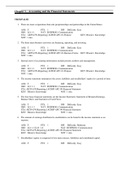Exam (elaborations)
Test Bank for Cornerstones of Financial Accounting, 3rd Edition Jay Rich| Chapter 01 Accounting and the Financial Statements
- Course
- Institution
- Book
Test Bank for Cornerstones of Financial Accounting, 3rd Edition Jay Rich| Chapter 01 Accounting and the Financial Statements
[Show more]



